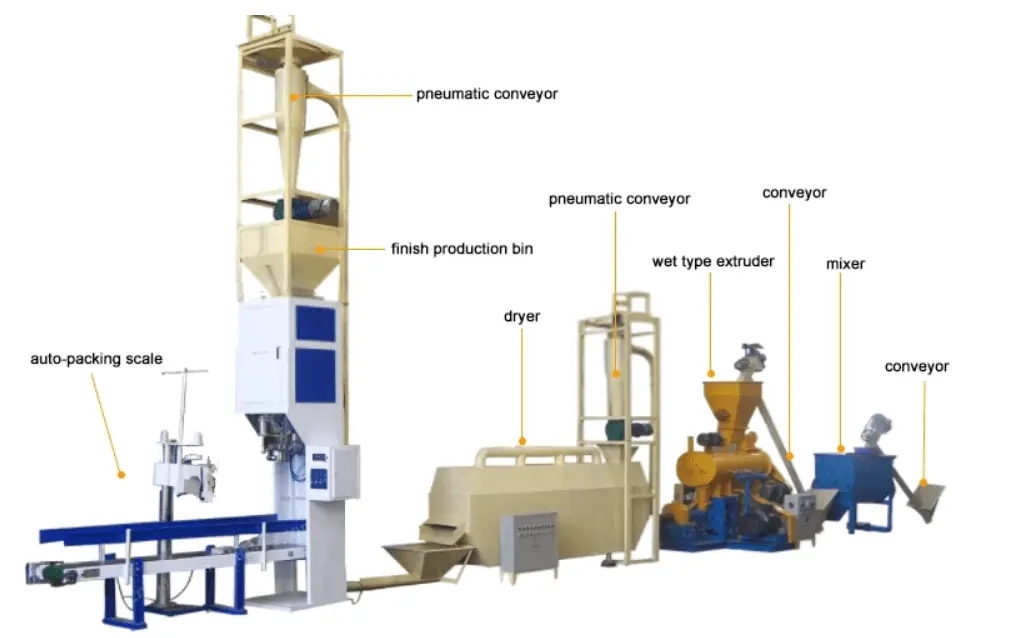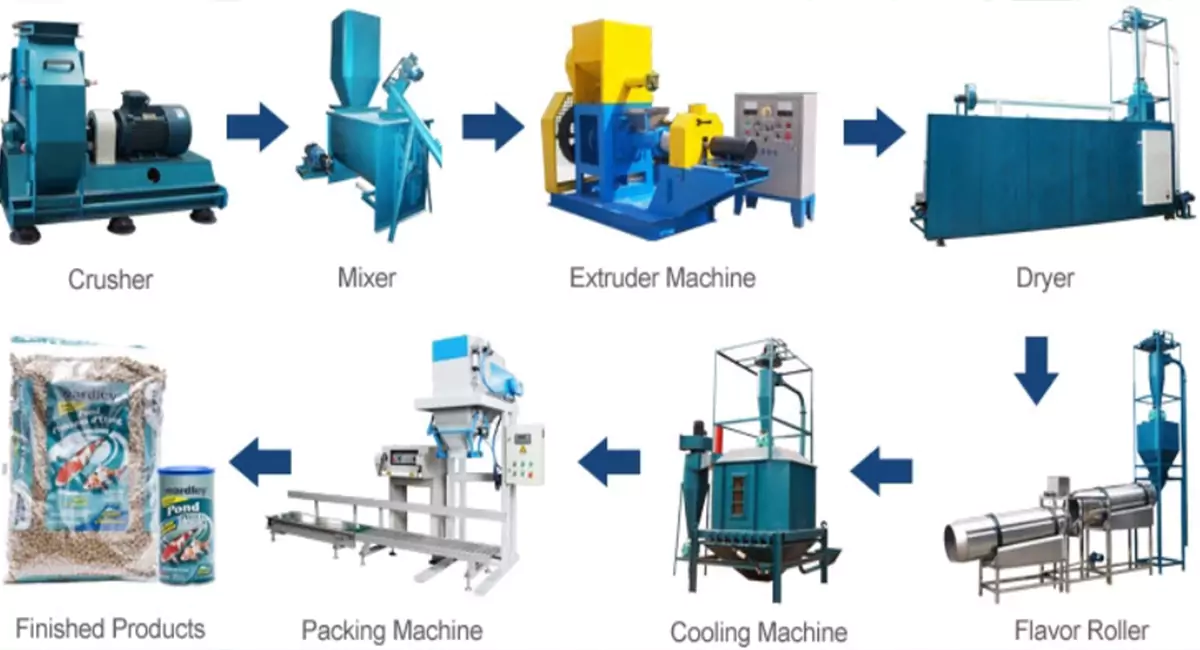Introduction to the Fish Farming Business in India
Fish farming in India is a very large business. It offers a great way to earn money and has become a very profitable industry. This work helps the whole country’s economy grow strong. It also provides good jobs for millions of people.
India is a perfect place to raise fish. The country has a very long coastline. It also has many wide rivers and large inland lakes. These water resources create huge potential for a successful aquaculture business. Because of this, the demand for high-quality fish feed is growing quickly. Good feed helps fish grow healthy and strong, which is key for any fish farm.
You maybe want to go into the market also. Or you might be thinking about starting a fish farming business in India to make fish feed. So your fisrt question may be about the cost of setting up a fish feed mill plant in India. The total cost depends on a clear business pan and several key things.
It includes to choose the right machinery for the fish feed mill plant in India, skilled workers, and a stable supply of raw materials. In this guide we will help you understand the fish feed mill plant design and how to choose the machinery in India.

Your Guide to Fish Feed Mill Plant Design and Machinery
The design of your fish feed factory is a very important step. Your fish feed mill plant layout and the machines you choose in India will greatly affect your total cost. Making smart choices here is a key part of planning your budget. Good equipment is a big investment, but it is needed to make the best quality fish feed. Knowing about your machine options is vital.
Extruder: To Cook and Shape the Feed
An extruder is a vital machine in the feed making process. It has two main jobs: 1.cooks the raw material mixture. 2. shapes the mixture into the final feed pellets. The type and quality of the extruder you buy can really change your costs and how fast you make feed.
Hammer Mill Grinder: To Grind Food for Better Digestion
Before you extrude the feed, you have to grind the raw materials into fine powder. A hammer mill grinder can turn ingredients like grains and crops into very fine powder. The smaller powder particle size is crucial which can help the fish digest easily and get all the needed nutrients.
Conveyors and Packaging: To Automate Your Workflow
A modern feed mill uses automation to save time and money. Conveyor systems are used to move the feed from one machine to the next. This reduces the need for manual labor. At the end of the line, automatic packaging systems get the product ready for shipping. This efficiency can lower your long-term operating costs.
Dryer: To Keep the Feed Fresh Longer
After the extruder makes the pellets, they are still hot and wet. They must be dried. The pellets move into a large dryer which gently removes extra moisture. This step is very important. It allows the fish feed to have a long shelf life and prevents it from spoiling.
Cooler: To Prepare Feed for Safe Storage
Cooling is the final step in fish feed mill plant before the feed is stored. A cooler machine brings the warm pellets down to room temperature. This makes the finished product safe to handle. It also gets the pellets ready for storage in bags or silos.

Understanding the Main Costs for Fish Feed Mill Plant
To create a smart budget, you need to understand the main costs of fish feed mill plant in India. Several key things will affect how much money you need to start and run your plant. Planning for these costs ahead of time is the first step toward building a successful business.
Choosing Your Machines: Local vs. Imported
The machines you buy are a big part of your startup costs. You have an important choice to make. You can purchase fish feed mill plant made in other countries. These imported models may offer new technology but they also have a higher price. On the other hand, you can buy from local sellers in India. Their equipment is often more friendly for your budget.
Labor Costs: How Skill and Location Affect Pay
The amount you pay your workers is another major operating cost. This cost can change based on two things. It depends on the skill level of your team. It also depends on where you choose to build your plant. Some regions in India have lower wage rules. Setting up your factory there could help reduce your labor expenses.
Raw Material Costs: Dealing with Price Changes
You have buy the raw ingredients regularly to make the fish feed. The price of the raw materials like soybean meal, fish meal, and corn meal can chage often. Their cost might go up or down along with the different seasons and market demand. Finding a reliable supplier of raw materials is the key to managing this variable cost.
Maintenance: A Long-Term Cost to Plan For
You have to take good care of the machines over time for keeping them working well. This is an ongoing maintenance cost that you must cost. This cost is regularly on service and checks. Also pays for any repairs or pars replacement. These will keep your fish feed mill plant running smoothly.
How Fish Feed Mill Plant Costs Change Across Indian States
It is very important to understand that costs are not the same everywhere in India. The price to build and run a fish feed mill plant can change a lot from one state to another. This is because of local raw material supply, labor wages, and how much demand there is for fish feed in that area.
Costs in Northern States (Punjab, Haryana, UP)
The northern part of India has many strong farms. In states like Punjab and Haryana, this can make it easier to find raw materials. However, the cost for land and workers is often higher. Land may cost around 3 to 4 lakhs per acre. Fish feed mill plant could be between 15 and 20 lakhs. You might pay a single worker 8,000 to 12,000 rupees a month. This means the total cost to set up a plant here is about 30 to 40 lakhs.
Costs in Western States (Maharashtra, Gujarat)
Western states like Maharashtra and Gujarat are known for industry. It is easy to find good machines and skilled workers here. But the land can be quite costly, perhaps 4 to 6 lakhs for an acre. There is also more competition, which can make raw materials more expensive. Machinery might cost 18 to 25 lakhs. Worker pay is around 10,000 to 15,000 rupees a month. In total, setting up a plant here may cost about 40 to 50 lakhs.
Costs in Southern States (TN, AP, Kerala)
Southern India is a huge center for fish farming, especially Andhra Pradesh. Raw materials are widely available here, and labor costs are reasonable. A worker may earn 9,000 to 13,000 rupees a month. But since so many farms need feed, demand is very high. This can raise fish feed mill plant prices to around 16 to 22 lakhs. Land is more affordable, maybe 2 to 3 lakhs per acre. The total setup cost here could be between 35 and 40 lakhs.
Costs in Eastern States (West Bengal, Odisha)
Eastern India is another key area for fish farming. In places like West Bengal, the costs can be lower. Land might only be 1.5 to 2.5 lakhs per acre, and labor could be 7,000 to 11,000 rupees a month. This can make it more affordable to start. However, you might face extra costs for shipping. Most suppliers of fish feed mill plant are in other parts of India. Even with machine costs of 15 to 20 lakhs, the total setup price is often the lowest, at around 28 to 35 lakhs.

Comparison on Fish Feed Mill Plant Cost
When contemplating an investment in a fish feed mill plant in India, it’s valuable to consider the costs in a broader global context. This allows you to gauge where India stands in terms of economic viability for such a venture, as compared to other major fish-producing nations. Here are some approximate costs:
| Country | Land Cost | Machinery Cost | Labor Cost | Total Setup Cost |
| India | ₹5,000-10,000 per hectare | ₹80,00,000-1,00,00,000 | ₹20,000-30,000 per month per worker | Approximately ₹1,00,00,000-1,50,00,000 |
| United States | $10,000-15,000 per acre | $10,000-150,000 | $3,000-4,000 per month per worker | Approximately $200,000-250,000 |
| China | ¥30,000-40,000 per mu | ¥700,000-900,000 | ¥4,000-6,000 per month per worker | Approximately ¥1,000,000-1,200,000 |
| Brazil | R$20,000-30,000 per hectare | R$400,000-600,000 | R$1,500-2,500 per month per worker | Approximately R$500,000-700,000 |
| Vietnam | ₫300-500 million per hectare | ₫2-3 billion | ₫3-5 million per month per worker | Approximately ₫3-4 billion |
